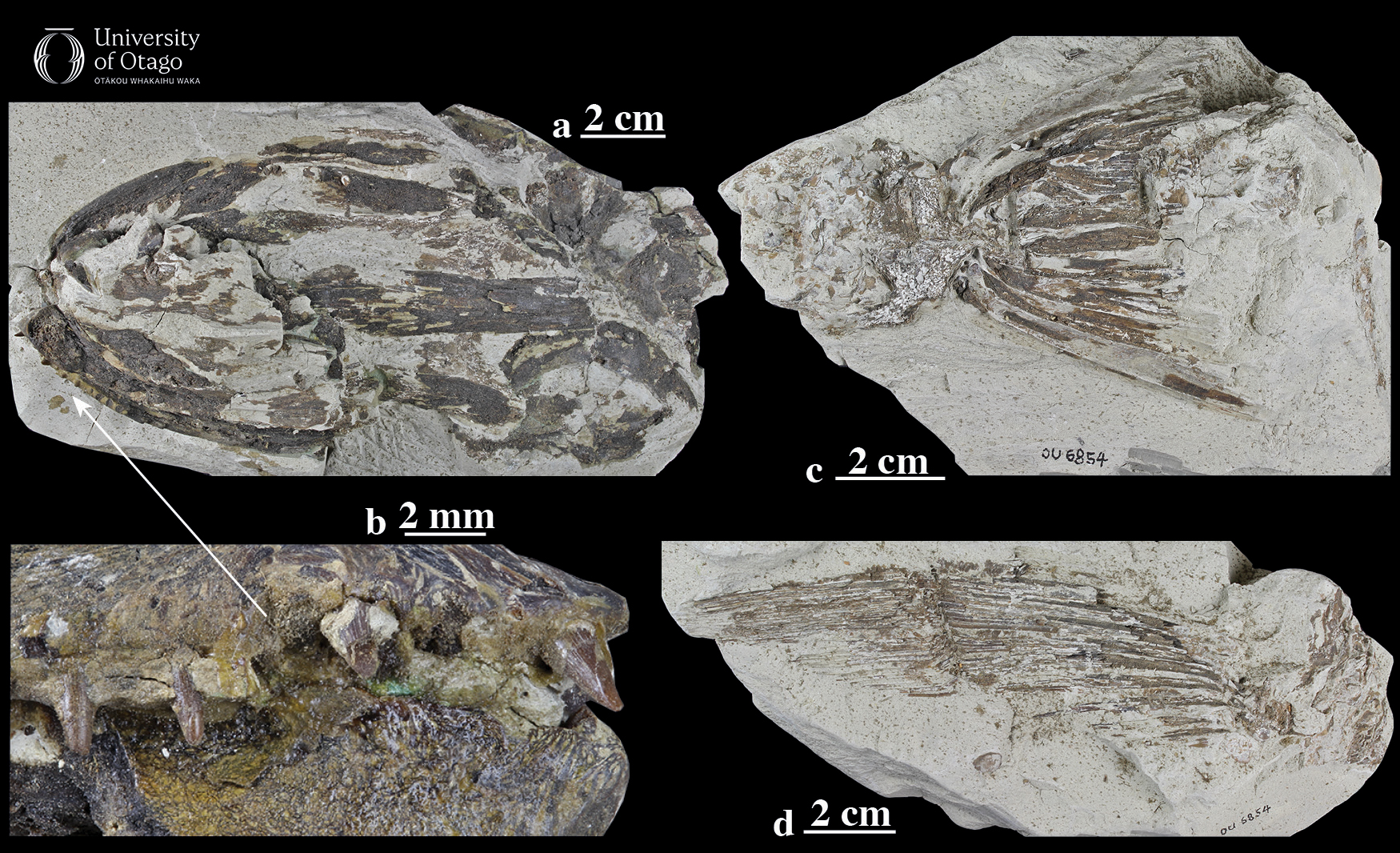8 Dawn barracouta from Dunedin studied across time
Osteichthyes, Scombriformes: Eothyrsites holosquamatus
The University of Otago Geology Museum holds within its collections many fossils with long and storied histories. Advances in knowledge and new discoveries can mean that a fossil might be studied and restudied by many students and other researchers often decades apart. This is one of the key reasons it is important to protect natural history collections for future generations – with fresh ideas from new researchers using emerging technologies we know there can be more to learn! And such has been the case with an ancient fish unearthed in a quarry near Ōtepoti Dunedin, less than ten kilometres from the University of Otago Geology Museum.
|
Fragments of the Dawn barracouta Eothyrsites holosquamatus (specimen OU6854). Images labelled a) and b) show the skull of the ancient fish, including a close up of the teeth. Image c) shows the tail of the fish and image d) shows one of the fins. Image source: Figure 3 in S Rust, and JH Robinson (2024) Revisiting Eothyrsites holosquamatus Chapman (Trichiuroidea: Gempylidae), an Eocene gemfish from the Burnside Mudstone, Dunedin, New Zealand, which is licensed under CC BY-NC-ND 4.0. Image credit: JH Robinson. |
Between 1929 and 1933 fragments of a fossil fish were found in a quarry in Burnside, a western suburb of Dunedin. The fossil was brought to the Chair of Geology and Mineralogy at the University of Otago, Professor WN (Noel) Benson. Professor Benson recognised that the fossil remains were from a fish and were important, and looked for help with identifying the fossil. But because geoscience expertise was still developing in Aotearoa New Zealand there was no one locally to provide the help that Professor Benson was seeking. Fortunately though, help was waiting on the other side of the Tasman Sea.
Frederick Chapman was the inaugural Australian Commonwealth Palaeontologist and was based in the National Museum in Melbourne, Australia. He had described fish fossils from Aotearoa in 1918, many years before Professor Benson received the Burnside fossil fish material. In 1933 Professor Benson visited Melbourne with two fossil fish from the University of Otago Geology Museum collections. One of these fossils was the Burnside fish, which was preserved in several fragments all from the same animal. The preserved parts included vertebrae, scales, a pectoral fin, and a fragment containing the lower jaw. Mr Chapman studied the material and recognised that the fish was a relative of predatory species found in the Australian and New Zealand region today. Mr Chapman named the fossil Eothyrsites holosquamatus, or ‘dawn barracouta entirely covered in scales’.
Eothyrsites holosquamatus was a long and slender fish that would have hunted other fish in the upper layer of open ocean waters that were 200 meters or more deep, an environment occupied by the living manga/maka New Zealand barracouta Thyrsites atun today. Eothyrsites holosquamatus would have been around 700 mm long and had a skull that was about 190 mm long. This ancient predatory fish lived in the middle to late Eocene between about 39 and 36 million years ago.
In the mid-1950s, more fossil fish fragments were discovered in the same location within the quarry in Burnside and were added to the Geology Museum collections. With Chapman’s death more than a decade earlier, Professor Benson looked elsewhere for help with studying these newly discovered fragments. However, this project would remain incomplete in Benson’s lifetime, and the new material drifted into obscurity in the Geology Museum collections. Decades later in the 1990s, University of Otago student Seabourne Rust rediscovered these fragments and re-examined them as part of his Master of Science thesis research. And several decades beyond that in the early 2020s, Seabourne Rust and Jeffrey Robinson would describe how the fragments discovered in the 1930s and in the 1950s were from the same individual fish, solving a 90 year old puzzle.
So is it barracouta or barracuda? Some readers might be more familiar with the latter spelling, especially if they know the famous song by Heart. Barracouta and barracuda are both correct but they are names for distantly-related fish. Species that are distant relatives can look very similar when they are the descendants of lineages that have faced similar challenges. The barracouta in this story refers to a type of snake mackerel in the family Gempylidae. Barracuda are instead species within the family Sphyraenidae. Both barracouta and barracuda are large, slender and swift predators, and have gained similar names owing to their similar appearance.
—Written by Daniel B Thomas
| Specimen numbers: OU 6329, OU 6332, OU 6854 | Age: Approximately 36 million years old (late Eocene, Kaiatan stage) |
| Locality: Ōtepoti Dunedin, Otago | Rock Formation: Burnside Marl |
| Collected by: Information not recorded | |
| Citations: Chapman F. 1935. Descriptions of fossil fish from New Zealand. Transactions and Proceedings of the Royal Society of New Zealand. 64:117–121; Rust S, Robinson JH. 2024. Revisiting Eothyrsites holosquamatus Chapman (Trichiuroidea: Gempylidae), an Eocene Gemfish from the Burnside Mudstone, Dunedin, New Zealand. Journal of the Royal Society of New Zealand 54:584–601. doi.org/10.1080/03036758.2023.2228211 | |
Evidence of life from a past geological age. Remains like bones, shells or wood, or an impression like a footprint, or some other evidence of life, from something that was alive more than 11,700 years ago.
The body of water between Australia and Aotearoa New Zealand.
The series of bones forming the flexible 'backbone' structure of the animals named for possessing these bones, the vertebrates.
The pair of fins located on either side of the body near the gills.
48.07 to 37.71 million years ago. The middle Eocene spans the international Lutetian and Bartonian stages.
37.71 to 33.90 million years ago. The late Eocene is more formally known as the international Priabonian Stage.


